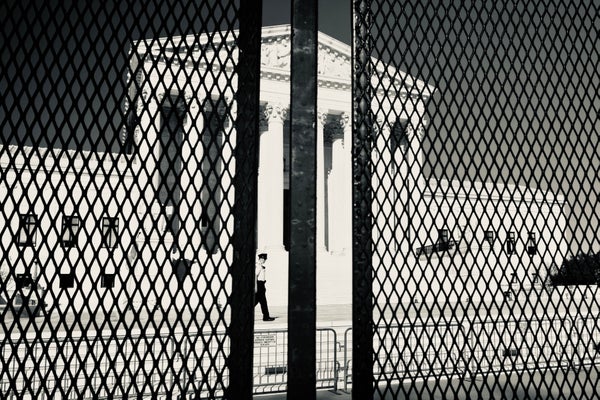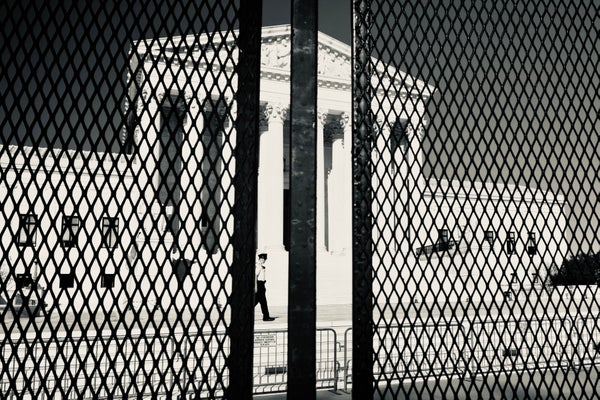The Supreme Court’s Contempt for History Promises a Worse Racial Future for U.S.
The high court treating the children of a highly educated slice of the U.S. as equivalent to people who descended from the history of enslavement and Jim Crow is a dishonest ruse

Douglas Rissing/Getty Images
Last summer the U.S. Supreme Court struck down universities’ use of race-based affirmative action, forbidding schools from considering race in deciding whether to admit qualified applicants. The high court’s majority relied on two tricks to do so—tricks that have been overlooked in much of the discussion of the relevant cases: Students for Fair Admissions, Inc. v. University of North Carolina and the accompanying suit against Harvard University. Both these ruses are reverberating, setting the U.S. up to be a worse, more racially unjust country.
In the first decision, the Court’s conservative majority manipulated the term “race” to mean something entirely different from what that word meant in the landmark ruling against racial segregation, 1954’s Brown v. Board of Education. Second, it used equally manipulated claims of discrimination made by particular Asian Americans trying to get into competitive colleges to attack affirmative action wholesale.
With the latest Supreme Court term now ended, here’s why these tricks matter: they distort the U.S. race relations history, writing falsehoods into law in a way that will make it even easier for others to attack racial justice in voting rights, employment, housing and criminal justice.
On supporting science journalism
If you’re enjoying this article, consider supporting our award-winning journalism by subscribing. By purchasing a subscription you are helping to ensure the future of impactful stories about the discoveries and ideas shaping our world today.
As I wrote in greater length in May in the journal Contexts, we should first consider the altered historical meaning of the Brown decision. In 2007, in a case regarding racial balance in Seattle schools, Chief Justice John Roberts quoted out of context the NAACP’s oral argument in Brown: “no State has any authority under the equal-protection clause of the Fourteenth Amendment to use race as a factor in affording educational opportunities among its citizens.” The idea that race cannot be considered at all, even to overcome racial inequity, is—to put it mildly—a controversial interpretation of Brown,which said that racial segregation of public schools was unconstitutional.
When Brown was decided in 1954, everyone knew that the term race was a stand-in for Black. The NAACP had mounted a decades-long campaign to end the U.S.’s racial caste system, where the doctrine of “separate but equal” kept formerly enslaved people and their descendants as second-class citizens. At the time of Brown, scarcely any other racial and ethnic groups besides white and black people lived in Topeka, Kan., or the other three communities from which the Brown cases were brought. In 1950, an estimated 0.3 percent of the American people belonged to ethnic groups that the Census now categorizes as Asian, 10 percent were Black, and Hispanic or Latino people were not yet represented in a distinct Census category.
Thurgood Marshall and the NAACP argued that states were using racial segregation to keep Black people subordinate. Marshall never argued that racial categories should be ignored as factors that influence human lives, only that race should not be used as part of a racial caste system.
And yet Roberts invoked Brown as a rhetorical ploy. “Eliminating racial discrimination means eliminating all of it,” Roberts wrote, ignoring the history of slavery, the Civil War and Jim Crow. In doing so, he used the iconic decision to end state-mandated racial segregation in public schools in 1954 to strike down university officials’ efforts to acknowledge and overcome racial disadvantage in 2023.
Second, consider how arguments about discrimination against Asian Americans and other Asian people were used to attack affirmative action wholesale. Certainly, Asian Americans have suffered a long history of discrimination in the U.S., including the notoriousChinese exclusion laws that started with the Chinese Exclusion Act of 1882 and the Supreme Court cases that upheld those laws. Japanese Americans were interned in camps during World War II. Research finds that, in the years since, Asian Americans have faced discrimination in their workplaces and communities. Since the COVID pandemic,Asian Americans have seen increased levels of violence and ridicule.
At the same time, as Natasha Warikoo points out in Is Affirmative Action Fair?, many Asian Americans in the U.S. today come from families descended from immigrants who were recruited to work, often for less pay or less residential stability, in high-status professional and technical occupations. Many chose to and were able to live where their kids could have the best educational opportunities.
This group accounts for the rapid proportional rise in Asian Americans admitted to selective schools. At Harvard, this year’s entering class is 29.9 percent Asian American, 15.3 percent African-American/Black, 11.3percent Hispanic/Latina/ Latino, 2.7 percent Native American/Native Hawaiian, and 40.8percent white. At the University of North Carolina, this year’s entering class is 25 percent Asian, 11 percent Black, 11 percent Hispanic or Latino, 2 percent Native American or Alaska Native and 63 percent white. Nationally, Asian Americans make up 5.7 percent of high school graduates, African Americans make up 14.6 percent, Hispanic or Latino people make up 20.2 percent, and white people account for 56.5 percent. In other words, while there may well be discrimination against Asian American applicants, they are successfully entering elite institutions in high proportions.
And here’s why that matters: treating the Asian American children of this highly educated slice of the U.S. as equivalent to people who descended from the history of enslavement and Jim Crow is a ruse. Conservative justices and their allies are trying to use the term “race” to erase the historical reality of the deep, multigenerational disadvantage suffered by African Americans. As Justices Sonia Sotomayor and Ketanji Brown Jackson wrote in their dissents, African Americans have suffered cumulative disadvantages in many spheres: in the failure to accumulate family wealth, in the accumulation of educational debt, in rates of incarceration, in the risk of being stopped by police—some of the latest manifestations of the racial caste system that Marshall and the NAACP were fighting in Brown.
In these cases and others, the Supreme Court is part of a larger national movement to rewrite the history and meaning of race in American society. InShelby County v. Holder in 2013, Roberts led a 5-4 majority to strike down parts of the Voting Rights Act. Roberts wrote, essentially, that because racial discrimination was over, states and counties with segregationist histories no longer had to clear potential changes to voting rules in advance with the U.S. Department of Justice’s Civil Rights Division. So what has happened since? Those jurisdictions have passed scores of new laws making it harder to vote, with a disproportionate impact on racial minority groups.
As with several state legislatures passing laws banning the teaching of what’s misleadingly called critical race theory or “divisive” topics on racial history, as with conservative attacks on “diversity” and any programs supporting it, the Court and its allies are whitewashing American racial history to shore up the current racial hierarchy in which white people remain politically and economically dominant. They’re working to create the fiction of a color-blind society while some states actively work to push Black Americans out of political life. We cannot let them.
This is an opinion and analysis article, and the views expressed by the author or authors are not necessarily those of Scientific American.

